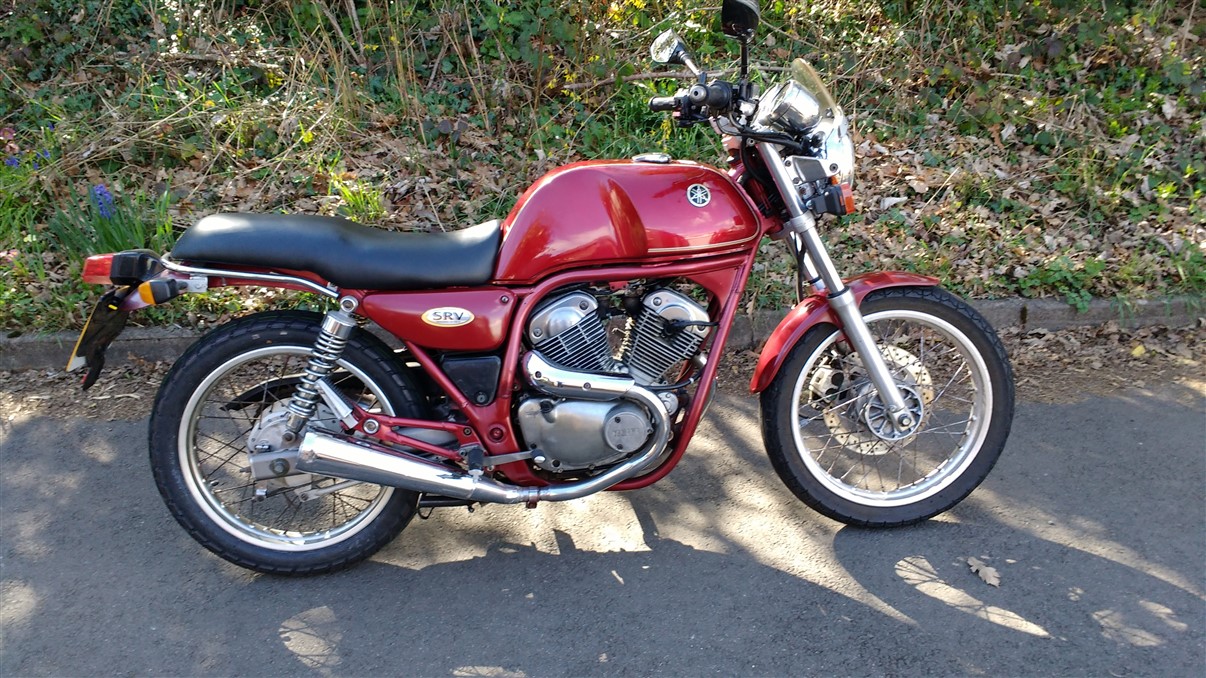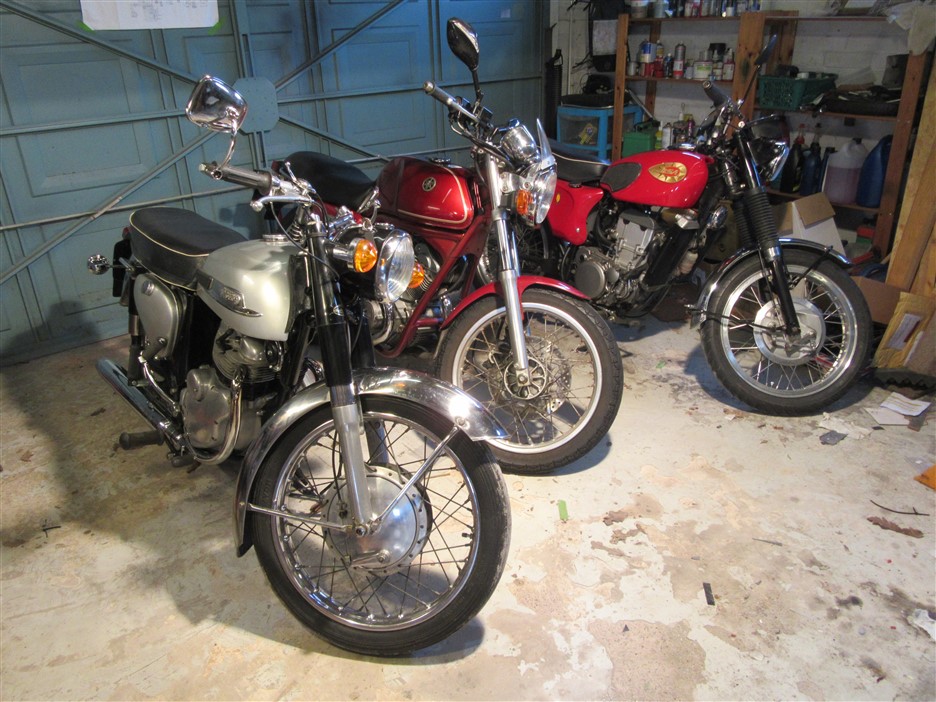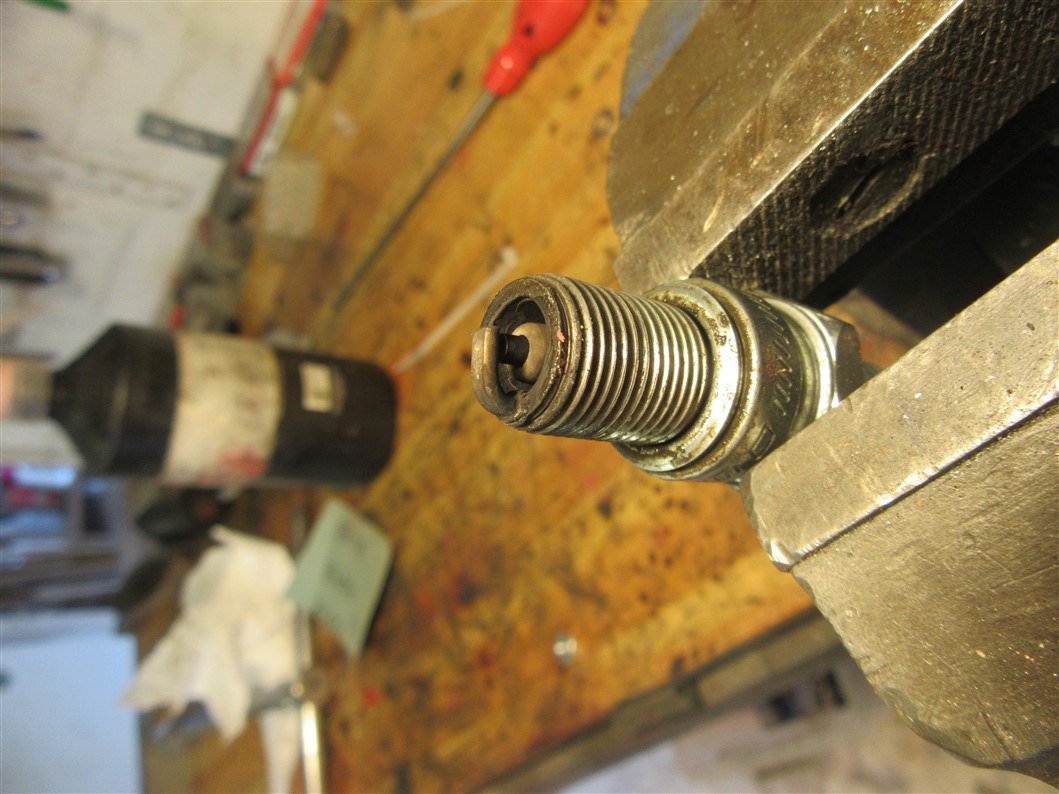With great help from Peter Holland, Al Osborn and Andy Sochanik (plus many others) I think I'm nearly there with my Electra. The electric starter is now starting it reliably despite the missing key between motor shaft and sprocket. It seems happiest starting from cold with closed air lever and a second or so tickling.
I've finally fitted the primary cover although why the NOC supplied gasket seems designed to go under two of the lower starter assembly legs beats me. I've cut those bits off.
Carburation is reasonable although an even slow idle is hard to come by. At first the mixture screw didn't seem to do much but now is at its best about 1.5 turns out as recommended. There may have been some muck in there that has been blown out. I've checked timing using my remote rotor and as I hoped it's much easier to see that than the alternator rotor. Strobing shows a satisfactory advance from the 10 degree (crankshaft) which seems about right for idle up to 20 degrees or so at 3,000 rpm which is the most I want to inflict on my neighbours at present.
It's very rattly although this is gradually lessening, I assume as oil finds its way where it needs to be. I'm guessing cam followers as I've carefully set and checked the rocker clearances. I have read that these are noisy engines but don't have much to compare.it with. There's no smoke from the exhausts and the oil is returning nicely.
I have been wondering about the voltage drop when using the starter - it goes down to about 10.4 volts - so am contemplating fitting a step-up voltage converter like the one in the link to ensure the Boyer gets enough volts.. In fact I've ordered one as it's only a fiver or so. I successfully used a similar device to get indicators to work on the 6 volt system of my ES2. It's probably unnecessary (I have a Mk 4 Boyer) but can't hurt anything. It will be fitted between ignition switched live and the Boyer live as well as the (positive) earth.
https://www.ebay.co.uk/itm/296547776080
So hopefully will hit the road soon!
If your Boyer functions OK…
- Log in to post comments
I take your point Michael,
However, as it would be wired in using existing bullet connectors, it would be the work of a moment to disconnect and reinstate as original. I'm not convinced I need it but may just try out of interest.
Push start? Beyond me I think. But you're right the kickstart is there and the engine starts fairly easily using it. The scenario that worries me - and why I replaced my ES2 with the Electra in the first place - is stalling the engine in traffic and being unable to restart while astride.
- Log in to post comments
The voltage converter arrived...
... this morning so it was an easy fitment. It does indeed step up (or down) the voltage it receives. However, it seems to do this in a fixed ratio with the input so as the input voltage drops so does what's available, so no advantage. But for a fiver I've learned something.
I suppose what I could do if I was minded would be to put a changeover relay so that in normal running the Boyer etc are fed direct but when starting they could be fed from this device. But that does seem like overkill.
I do think it was worth a try. I have also discovered that the battery needs to be pretty much fully charged otherwise cranking voltage drops below 10.
- Log in to post comments
Boyer & Electra Starting.
Boyer & Electra Starting...
A friend of mine used to start his Electra on the button, by cranking the engine up to speed, then when he released the starter button - it fired! (as the battery voltage rose enough to power the Boyer).
This phenomenon has been well known for ages - my 1980's Vauxhall Viva had a ballast resistor in line with the power lead to the ignition coil, which was by-passed when the starter was pressed - thus full volts were provided to the coil when needed.
Commandos used ballast resistors on their coils, for the same reason - even though a functioning starter did not arrive until 1976.
Sadly, this idea will not work with Boyer, as 12v is required, whereas the ballast resistor system used 6v coils.
- Log in to post comments
Clatter on Lightweight Twins....
The clatter on Lightweight Twins generaly comes from the cam followers, as you correctly imagine. The cam lifts them off-centre, with idea being that they will rotate to even out wear. The reality is that over time, the stem wears into a barrel shape - little wear in the centre, but well worn at top and bottom of travel.
There is little you can do about this - but you need to keep an eye on this, as the wobble introduced by extreme wear will affect the cam follower face, where it meets the cam, and will also damage your cams.
Its one of the things you need to check on high mileage engines - or if the clattering is excessive
- Log in to post comments
Thanks Andy.
Yes, I've noticed that it sometimes fires on releasing the button. If I could time this correctly..... Ambient temperature seems to have a lot of influence - last week in the warm weather it was starting reliably, this week as it's colder it's struggling a bit. But being a fair weather rider these days I don't think it'll be an issue.
I seem to remember from my long ago days as an AA patrol that it was Ford that first used the ballast resistor, and as you say my 850 Commando had one as it had 6 volt coils. But of course it was in circuit all the time.
The rattle isn't too loud although don't have any reference point so think I'll leave well(?) alone.
- Log in to post comments
Get more battery capacity,…
Get more battery capacity, maybe by adding another battery.
- Log in to post comments
120 CCA...
... which I would have thought enough. It spins the engine over very happily. As a matter of interest I've just popped the plugs out and they were black so cleaned them with a bit of carb cleaner and the engine started on the first push. Fully charged battery however.
This site has some interesting stuff about battery CCA etc. An interesting table showing how available power drops off with temperature - and how CCA is measured. Temperature has a far bigger effect than I had realised. But as I say, we FWBs don't care!
- Log in to post comments
I find my two 12v batteries…
I find my two 12v batteries that fit the original battery holders, wired in parallel and kept we'll charged works well for me Ian. They are Yuasa YB5L-Bs 12v 5.2Ah 65 CCA and very reasonably priced at £20.88 each from Tayna Batteries. I'm still looking for something a little more powerful that will still fit the original holders - every little helps with even the Pazon EI being sensitive to voltage drop!
- Log in to post comments
The battery I have...
is aYB9-AGM Powerline again from Tayna. It should be enough at 120 CCA and 9Ah.
https://www.tayna.co.uk/motorcycle-batteries/powerline/yb9-b-agm/
I'd be interested if anybody could tell me what voltage they get when the engine is cranking. With a charged battery I'm getting around 10.4 volts. Voltage at rest is 12.7.
- Log in to post comments
2 x Motobatt MB5U Batteries
Further to my last comment about using 2 x Yuasa YB5L-B batteries successfully in parallel on my Electra I have been doing some research over replacements because they are 3 years old and beginning to show their age. I have tracked down a higher capacity AGM battery - the Motobatt MB5U (photo attached). It is a direct physical replacement at 120mm x 60mm x 130mm so will fit in the original battery holders which for me is essential. They are 12 v 7 AH with 90 Amperes CCA and 160 Amperes CA so significantly more powerful than the Yuasa YBL-Bs I have been using successfully.
The down side is they are more expensive at £32.56 each but if they improve the Electra's cold start performance then it will be cost effective and well worth doing I have ordered two for delivery next week - I will report back on how they perform!
Cheers and good luck with yours Ian! Nick
- Log in to post comments
Battery carrier
Can someone post a picture showing how Electra batteries are mounted please?
- Log in to post comments
I am changing my batteries…
I am changing my batteries tomorrow John and will photograph the original battery holders and attach them here - one is under the screw on cover in the left side battery and tool box and the second battery in the holder under the seat between the rear mudguard and centre section.
Nick
- Log in to post comments
RANT
Rant coming up, I do not like the principal of two bats in parallel, if one starts to go down then the better one charges the flatter and on, till they both become flat! It is very easy to use two batts of different age, (by mistake) especially if one has been in store for longer. The original Electra set up of two 6V in series was also a Norton factory bodge, as it saved them finding the space for a 12V battery which in 1960 was not readily available. (No wonder the Japanese blew us 'away' when the Electra died) (why MUST you have originality when it is over 70yrs old???)
You can fit a MB9U under the seat and works especially when the starter is cold. When it is hot the sprag looses interest.
Now another trick. If you take the original ignition switch and ammeter (and associated wiring) out of circuit during startup you save another 0.5V
And another thing, the information on the Voltage Boost with BB in mind, as you have snagged it saves me buying one and seeing how it performed?
- Log in to post comments
All invaluable and wise…
All invaluable and wise expert advice as always Alan! That said it is a solution which has worked pretty well for almost three years, perhaps because I check the batteries are fully charged every time I service the bike. Having already ordered those more powerful batteries I will see how they perform. I can always go for your single bigger MB9U battery solution if they don't work out. As for originality - I'm just stubborn! However, I am minded to source a spare side battery box and see if I can adapt it to take a really powerful single battery which will solve the original Norton bodge. All part of the joy of Norton Lightweight ownership! Best wishes. Nick
- Log in to post comments
The Electra...
... is now starting immediately the button is pressed (without the fancy voltage controller). I put it down to warmer weather and a fully charged battery.
I have to say I forsook it this afternoon for a shakedown pre-MoT and pre-sale run on my little Yamaha V-twin. A very pleasant ride but am looking forward to getting on the Norton!

- Log in to post comments
That Yam is cute! You don't…
That Yam is cute! You don't see many of them.
Dan
- Log in to post comments
Yes, that Yam is cute. Leave…
Yes, that Yam is cute. Leave it alone Ian. Just skin deep.
Stop teasing the Norton by starting it and refusing to take it out.
Get on it and go!!! You'll love it.
I can't stand the tension.
- Log in to post comments
I will, I will....
... but initial rides will just be up & down my local lane (Icknield Street) so it isn't too far to push home.
On the meantime here are my 3 bikes while all present and correct.

- Log in to post comments
What's going on..
...with that Beeza in the background? Seems to have forgotten its C15 roots!
- Log in to post comments
Well spotted Michael....
... it's fitted with an ex-CCM Suzuki DRZ400 engine by a previous owner. A nice engineering job with even gearchange and rear brake on the proper sides although I needed to change the former to one up four down to work in correct (ie Norton) pattern. It also needed a lot of minor but important tweaking. I've only ridden it once - couldn't get on with the Triumph gearchange pattern - but it went very well.
- Log in to post comments
OK I give in....
... so pushed the little Norton out of the garage into the sunlight, started it up (first push of the button) and wobbled off for a very short - 2 miles or so - ride backwards and forwards along the local lane.
Good points:
Excellent riding position, good brakes, lovely planted feel. Plenty of urge - pulled up a hill - maybe 1 in 10 - in top with no trouble. Decent gearchange although there was too much slack in the clutch cable so neutral was somewhat elusive. It's a much nicer ride than the Yam, to my relief.
Bad points:
Only one really. It doesn't like to restart after the first try. I managed to stall it when trying to set off and it took several goes to get it running again. The same when I deliberately stopped the engine half way through my little run. I suspect the plugs (Champion N4C) may be on the hard side? And I've only been able to adjust the mixture when it's been cold so that needs some attention. The problem is that having had one hip and one knee replaced, I find getting my foot up far enough to use the kickstart almost impossible. Hence my choice of the Electra.
So I'm feeling much more confident about taking it for a longer run as long as I don't have to stop the engine!
- Log in to post comments
A quick look at the plugs...
... shows a nice colour although interestingly not wet at all. I'm still wondering whether there's enough voltage to trigger the Boyer properly although this may be leading me along the primrose path. I'm also tempted to try a couple of NGK (B6ES?) plugs or maybe even posh platinum ones. There do seem to be plenty of sparks at the plug when spun over.

- Log in to post comments
I have a theory....
..When I rewired the bike I used very heavy duty (10 sq mm) cables for the main earth and starter / solenoid connections, reasoning that this would minimise voltage loss and give the starter motor the best chance of operating. This has proved very successful in that respect. However, I am led to wonder whether the large current draw from the battery which this allows may drop the available voltage at the Boyer below its minimum level. Maybe this is why it start instantly with a fully charged battery, but on subsequent attempts the battery voltage will have dropped - maybe by just enough?
I plan to try connecting in an external battery to the Boyer so that it's getting its full whack. Not viable for actual riding but may lead me to revisiting my voltage controller idea with relay control.
- Log in to post comments
I thought, but may be wrong!…
I thought, but may be wrong!.... that the new Boyers were less susceptible to voltage drop? I suppose the pertinent question is whether the failure to restart is immediately after the first start and so before the engine is warm. If its after its warmed up you may have to fiddle to get to know what choke/tickling the bike likes when its hot.
Dan
- Log in to post comments
Yes,
Boyer say that the version I have ( a new one, Mk 4) works down to 7.5 volts. I did try what I outlined with an auxiliary battery and it seemed to make some improvement.
However - I have discovered that I can get an almost reliable start by only letting the starter operate for a couple of revolutions then releasing the button. I've been letting it churn over for several seconds. So maybe the problem all along has been my technique. Give me an ES2 with a valve lifter and I know exactly what to do!
- Log in to post comments
I pressing the button until…
I pressing the button until it spins, releasing it and as you release it, it starts while still spinning, then this would seem to be definitely low volts.
As you remove the starter load, the volts will shoot up.
However, having said that, if it starts from cold, when the load is even greater, then that would not seem sensible.
I think a change of plugs as suggested may be a good idea.
- Log in to post comments




If your Boyer functions OK at that 10.4 V cranking voltage, then putting an extra electronic device in line with it would be against my principles.
A failed stepper-up will be a roadside breakdown.
If the battery gets low and fails to give the Boyer enough cranking volts, that's not a breakdown because there's a kickstart and the option to push-start.